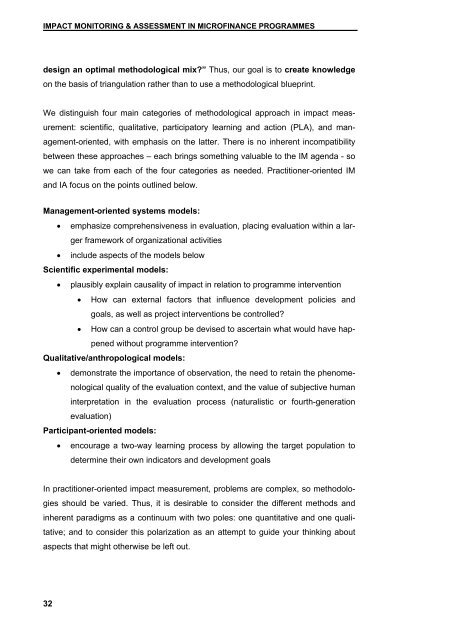Guidelines for Impact Monitoring & Assessment in Microfinance ...
Guidelines for Impact Monitoring & Assessment in Microfinance ...
Guidelines for Impact Monitoring & Assessment in Microfinance ...
You also want an ePaper? Increase the reach of your titles
YUMPU automatically turns print PDFs into web optimized ePapers that Google loves.
IMPACT MONITORING & ASSESSMENT IN MICROFINANCE PROGRAMMES<br />
design an optimal methodological mix?” Thus, our goal is to create knowledge<br />
on the basis of triangulation rather than to use a methodological bluepr<strong>in</strong>t.<br />
We dist<strong>in</strong>guish four ma<strong>in</strong> categories of methodological approach <strong>in</strong> impact measurement:<br />
scientific, qualitative, participatory learn<strong>in</strong>g and action (PLA), and management-oriented,<br />
with emphasis on the latter. There is no <strong>in</strong>herent <strong>in</strong>compatibility<br />
between these approaches – each br<strong>in</strong>gs someth<strong>in</strong>g valuable to the IM agenda - so<br />
we can take from each of the four categories as needed. Practitioner-oriented IM<br />
and IA focus on the po<strong>in</strong>ts outl<strong>in</strong>ed below.<br />
Management-oriented systems models:<br />
32<br />
• emphasize comprehensiveness <strong>in</strong> evaluation, plac<strong>in</strong>g evaluation with<strong>in</strong> a larger<br />
framework of organizational activities<br />
• <strong>in</strong>clude aspects of the models below<br />
Scientific experimental models:<br />
• plausibly expla<strong>in</strong> causality of impact <strong>in</strong> relation to programme <strong>in</strong>tervention<br />
• How can external factors that <strong>in</strong>fluence development policies and<br />
goals, as well as project <strong>in</strong>terventions be controlled?<br />
• How can a control group be devised to ascerta<strong>in</strong> what would have happened<br />
without programme <strong>in</strong>tervention?<br />
Qualitative/anthropological models:<br />
• demonstrate the importance of observation, the need to reta<strong>in</strong> the phenomenological<br />
quality of the evaluation context, and the value of subjective human<br />
<strong>in</strong>terpretation <strong>in</strong> the evaluation process (naturalistic or fourth-generation<br />
evaluation)<br />
Participant-oriented models:<br />
• encourage a two-way learn<strong>in</strong>g process by allow<strong>in</strong>g the target population to<br />
determ<strong>in</strong>e their own <strong>in</strong>dicators and development goals<br />
In practitioner-oriented impact measurement, problems are complex, so methodologies<br />
should be varied. Thus, it is desirable to consider the different methods and<br />
<strong>in</strong>herent paradigms as a cont<strong>in</strong>uum with two poles: one quantitative and one qualitative;<br />
and to consider this polarization as an attempt to guide your th<strong>in</strong>k<strong>in</strong>g about<br />
aspects that might otherwise be left out.

















![CynefinFramework final [Read-Only]](https://img.yumpu.com/19017304/1/190x135/cynefinframework-final-read-only.jpg?quality=85)